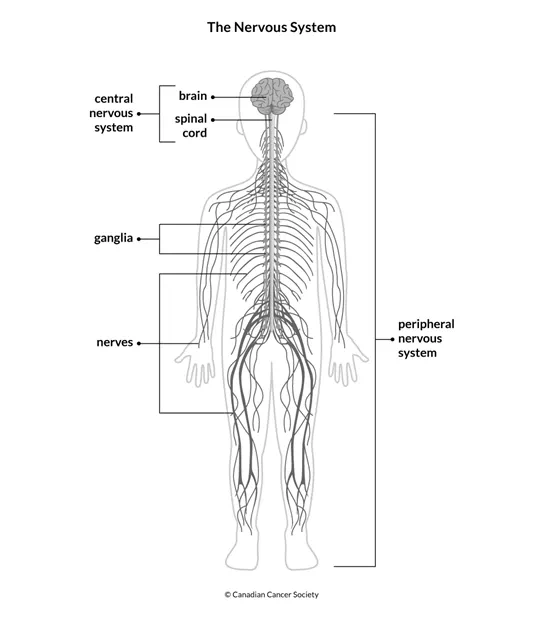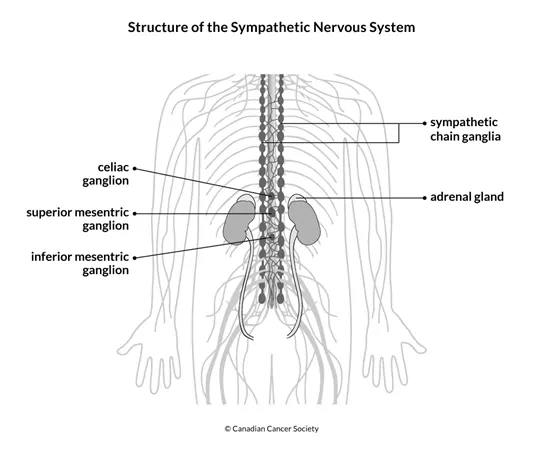Anatomy and physiology of the nervous system
The nervous system is a complex network of nerves and nerve cells (neurons) that carry signals or messages to and from the brain and spinal cord to different parts of the body. It is made up of the central nervous system and the peripheral nervous system.

The central nervous system (CNS) is made up of the brain and spinal cord. The brain controls most body functions, including awareness, movements, sensations, thoughts, speech and memory. The spinal cord is connected to the brain at the brain stem and is covered by the vertebrae of the spine. Nerves exit the spinal cord to both sides of the body. The spinal cord carries signals back and forth between the brain and the nerves in the rest of the body.
The peripheral nervous system (PNS) is the part of the nervous system outside of the CNS. It is made up of nerves and ganglia that send signals to and receive signals from the CNS. The PNS is divided into the somatic nervous system and the autonomic nervous system. The somatic nervous system controls body movements that are under our control such as walking. The autonomic nervous system controls involuntary functions that the body does on its own such as breathing and digestion.
The autonomic nervous system is further divided into the sympathetic and parasympathetic nervous systems. The sympathetic nervous system prepares the body for situations that require strength and heightened awareness or situations that arouse fear, anger, excitement or embarrassment. This is called the fight-or-flight response. It causes the heart to beat faster, makes you breathe quicker and more shallowly, dilates the pupils and increases metabolism. The parasympathetic nervous system has a calming effect on the body. It returns heart rate and breathing to normal, constricts the pupils and slows down metabolism to conserve energy.
Structure and function of the sympathetic nervous system

The sympathetic nervous system is made up of the following parts.
Sympathetic chain
The sympathetic chain is made of the sympathetic chain ganglia that run in a chain from the head to the tailbone (coccyx), along both sides of the spine. Ganglia are clusters of nerve cell bodies. The sympathetic chain ganglia send messages to the head, neck, lower body (trunk) and extremities during the fight-or-flight response.
The sympathetic chain ganglia affect spinal nerves and nerves in the chest cavity. This helps to increase blood flow to skeletal muscles and the brain, stimulate energy production for skeletal muscles to use, release stored fats and stimulate the sweat glands. It also increases heart rate, increases the pumping action of the heart and allows more air to move into the lungs.
Collateral ganglia
The 3 collateral ganglia are the celiac ganglion, the superior mesenteric ganglion and the inferior mesenteric ganglion. They are in the abdomen in front of the spine. The collateral ganglia send messages to organs in the abdomen and pelvis.
The collateral ganglia affect nerves in the abdomen and pelvis. Affecting these nerves lowers blood flow to organs, lowers activity in the digestive system, stimulates the liver to release glucose to give the body more energy, relaxes smooth muscle in the bladder wall and lowers urine production.
Adrenal medulla
The adrenal medulla is located in the centre of each adrenal gland. These glands have specialized neurons. When these neurons are stimulated, they release chemical messengers (called neurotransmitters) into the blood that act as hormones.
The adrenal medulla is involved in releasing hormone-like substances, such as epinephrine (adrenaline) and norepinephrine (noradrenaline), into the blood. Cells that have receptors for epinephrine or norepinephrine respond to these substances and take part in the flight-or-fight response.
